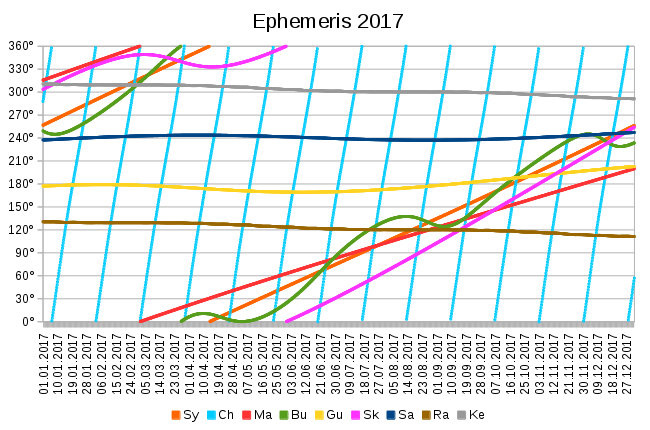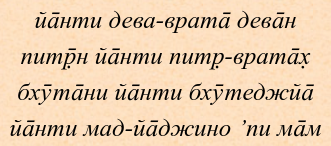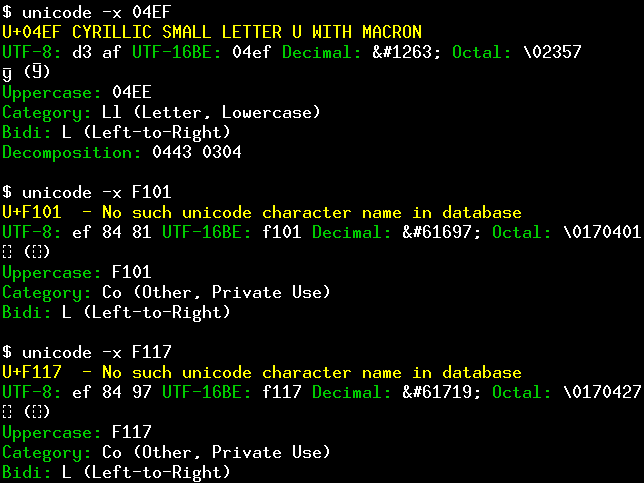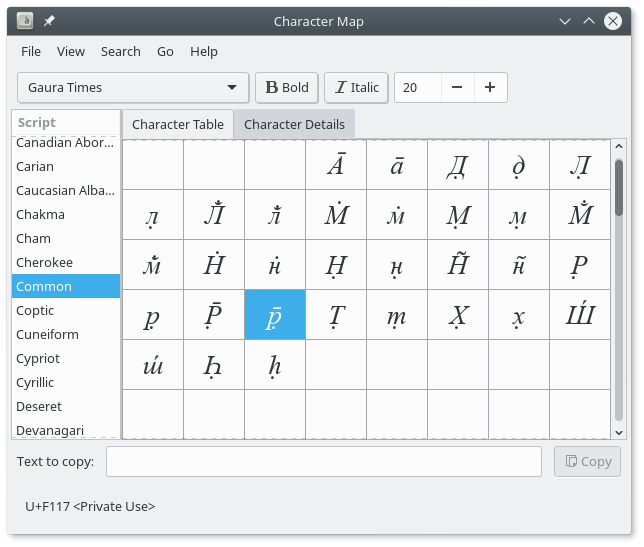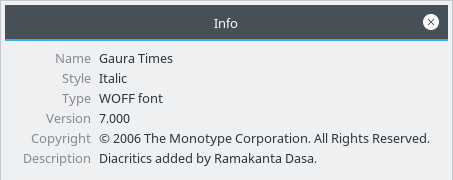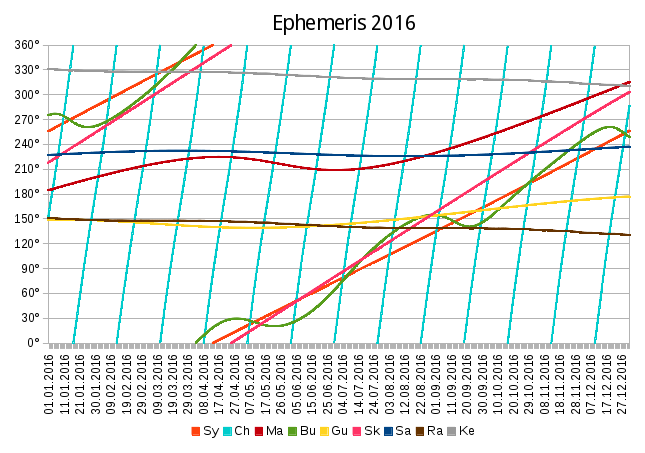Earlier this year, we published a blog post with a graphical ephemeris and a list of rāśi and nakṣatra transits for 2016. It is December already and with New Year approaching, it is time to publish an update for the upcoming 2017.
As a nice complement to this post, the retrograde motion calendar for years 2016 to 2020 we published earlier is still valid and covers 2017 as well. Also, remember that if you have Chakra Darshana on your Android phone or tablet, it can automatically notify you about transits and direction changes as they happen.
Continuing the already established format for such posts, the following picture shows the graphical ephemeris for 2017 with crossing points allowing to visually identify rāśi transits and conjunctions (click on the image for viewing the chart at a larger scale):
Rāśi transit data is provided below in tabular form. In order to keep the table sufficiently narrow for the Web page format, it is organized as follows. Rows are sorted by date and time in UTC, giving a chronological sequence of events. Transits for Candra are omitted, because that would make the table very long. Transits for Sūrya, Maṅgala, Budha, and Śukra are listed in separate columns, because they transit often and having a separate column makes it easy to visually filter transits for that particular graha. Transits for Guru, Śani, Rāhu, and Ketu are listed in a single combined column on the right, because they only transit rarely:
| Date | Time | Sy | Ma | Bu | Sk | Gu-Sa-Ra-Ke |
|---|---|---|---|---|---|---|
| 14.01.2017 | 02:08 | Makara | ||||
| 20.01.2017 | 08:18 | Mīna | ||||
| 26.01.2017 | 14:00 | Sa - Dhanu | ||||
| 27.01.2017 | 14:47 | Mīna | ||||
| 03.02.2017 | 07:49 | Makara | ||||
| 12.02.2017 | 15:08 | Kumbha | ||||
| 22.02.2017 | 13:16 | Kumbha | ||||
| 01.03.2017 | 21:09 | Meṣa | ||||
| 10.03.2017 | 21:07 | Mīna | ||||
| 14.03.2017 | 12:02 | Mīna | ||||
| 27.03.2017 | 02:05 | Meṣa | ||||
| 12.04.2017 | 22:41 | Vṛṣabha | ||||
| 13.04.2017 | 20:34 | Meṣa | ||||
| 14.05.2017 | 17:26 | Vṛṣabha | ||||
| 26.05.2017 | 20:02 | Mithuna | ||||
| 31.05.2017 | 03:26 | Meṣa | ||||
| 03.06.2017 | 14:23 | Vṛṣabha | ||||
| 15.06.2017 | 00:02 | Mithuna | ||||
| 18.06.2017 | 17:22 | Mithuna | ||||
| 20.06.2017 | 23:09 | Sa - Vṛścika | ||||
| 29.06.2017 | 14:04 | Vṛṣabha | ||||
| 02.07.2017 | 21:34 | Karka | ||||
| 11.07.2017 | 09:29 | Karka | ||||
| 16.07.2017 | 10:54 | Karka | ||||
| 21.07.2017 | 04:50 | Siṃha | ||||
| 26.07.2017 | 11:38 | Mithuna | ||||
| 16.08.2017 | 19:17 | Siṃha | ||||
| 21.08.2017 | 05:21 | Karka | ||||
| 27.08.2017 | 02:59 | Siṃha | ||||
| 08.09.2017 | 23:58 | Ra - Karka | ||||
| 08.09.2017 | 23:58 | Ke - Makara | ||||
| 12.09.2017 | 01:21 | Gu - Tulā | ||||
| 15.09.2017 | 05:01 | Siṃha | ||||
| 16.09.2017 | 19:10 | Kanyā | ||||
| 26.09.2017 | 18:59 | Kanyā | ||||
| 09.10.2017 | 15:55 | Kanyā | ||||
| 13.10.2017 | 10:32 | Kanyā | ||||
| 13.10.2017 | 18:22 | Tulā | ||||
| 17.10.2017 | 07:05 | Tulā | ||||
| 26.10.2017 | 09:57 | Sa - Dhanu | ||||
| 01.11.2017 | 19:14 | Vṛścika | ||||
| 02.11.2017 | 18:30 | Tulā | ||||
| 16.11.2017 | 06:51 | Vṛścika | ||||
| 24.11.2017 | 08:24 | Dhanu | ||||
| 26.11.2017 | 16:38 | Vṛścika | ||||
| 29.11.2017 | 23:51 | Tulā | ||||
| 10.12.2017 | 22:48 | Vṛścika | ||||
| 15.12.2017 | 21:30 | Dhanu | ||||
| 20.12.2017 | 13:01 | Dhanu |
The following table, organized by the same principle, gives nakṣatra transit data:
| Date | Time | Sy | Ma | Bu | Sk | Gu-Sa-Ra-Ke |
|---|---|---|---|---|---|---|
| 04.01.2017 | 00:46 | Śatabhiṣa | ||||
| 07.01.2017 | 01:15 | P. Bhādrapadā | ||||
| 10.01.2017 | 19:35 | U. Aṣāḍhā | ||||
| 16.01.2017 | 23:01 | P. Bhādrapadā | ||||
| 21.01.2017 | 07:42 | P. Aṣāḍhā | ||||
| 23.01.2017 | 21:56 | Śravaṇa | ||||
| 24.01.2017 | 19:04 | U. Bhādrapadā | ||||
| 26.01.2017 | 14:00 | Sa - Mūla | ||||
| 31.01.2017 | 11:49 | U. Bhādrapadā | ||||
| 31.01.2017 | 22:35 | U. Aṣāḍhā | ||||
| 06.02.2017 | 01:02 | Dhaniṣṭhā | ||||
| 10.02.2017 | 03:05 | Śravaṇa | ||||
| 11.02.2017 | 17:03 | Revatī | ||||
| 18.02.2017 | 13:36 | Dhaniṣṭhā | ||||
| 19.02.2017 | 05:38 | Śatabhiṣa | ||||
| 21.02.2017 | 02:53 | Revatī | ||||
| 26.02.2017 | 09:29 | Śatabhiṣa | ||||
| 01.03.2017 | 21:09 | Aśvinī | ||||
| 04.03.2017 | 11:51 | P. Bhādrapadā | ||||
| 05.03.2017 | 16:31 | P. Bhādrapadā | ||||
| 12.03.2017 | 13:50 | U. Bhādrapadā | ||||
| 15.03.2017 | 02:44 | U. Bhādrapadā | ||||
| 17.03.2017 | 20:24 | U. Bhādrapadā | ||||
| 19.03.2017 | 09:16 | Revatī | ||||
| 20.03.2017 | 08:39 | Bharaṇī | ||||
| 27.03.2017 | 02:05 | Aśvinī | ||||
| 31.03.2017 | 07:10 | Revatī | ||||
| 08.04.2017 | 04:22 | Kṛttikā | ||||
| 10.04.2017 | 08:52 | P. Bhādrapadā | ||||
| 13.04.2017 | 20:34 | Aśvinī | ||||
| 14.04.2017 | 08:17 | Gu - Hasta | ||||
| 20.04.2017 | 15:01 | U. Bhādrapadā | ||||
| 27.04.2017 | 08:55 | Rohiṇī | ||||
| 27.04.2017 | 12:21 | Bharaṇī | ||||
| 29.04.2017 | 00:30 | Ke - Dhaniṣṭhā | ||||
| 11.05.2017 | 06:32 | Kṛttikā | ||||
| 15.05.2017 | 17:06 | Revatī | ||||
| 16.05.2017 | 22:13 | Mṛgaśīrṣa | ||||
| 23.05.2017 | 05:56 | Bharaṇī | ||||
| 25.05.2017 | 02:45 | Rohiṇī | ||||
| 31.05.2017 | 03:26 | Aśvinī | ||||
| 01.06.2017 | 14:19 | Kṛttikā | ||||
| 05.06.2017 | 19:51 | Ārdrā | ||||
| 08.06.2017 | 00:36 | Mṛgaśīrṣa | ||||
| 09.06.2017 | 02:27 | Rohiṇī | ||||
| 13.06.2017 | 17:57 | Bharaṇī | ||||
| 15.06.2017 | 15:24 | Mṛgaśīrṣa | ||||
| 20.06.2017 | 23:09 | Sa - Jyeṣṭhā | ||||
| 21.06.2017 | 18:19 | Ārdrā | ||||
| 21.06.2017 | 23:38 | Ārdrā | ||||
| 26.06.2017 | 01:09 | Punarvasu | ||||
| 26.06.2017 | 11:41 | Kṛttikā | ||||
| 27.06.2017 | 22:52 | Punarvasu | ||||
| 04.07.2017 | 15:18 | Puṣya | ||||
| 05.07.2017 | 23:09 | Punarvasu | ||||
| 08.07.2017 | 17:32 | Rohiṇī | ||||
| 12.07.2017 | 04:53 | Aśleṣā | ||||
| 16.07.2017 | 13:00 | Puṣya | ||||
| 19.07.2017 | 22:44 | Puṣya | ||||
| 20.07.2017 | 15:10 | Mṛgaśīrṣa | ||||
| 21.07.2017 | 04:50 | Maghā | ||||
| 01.08.2017 | 06:50 | Ārdrā | ||||
| 02.08.2017 | 17:44 | P. Phalgunī | ||||
| 02.08.2017 | 21:33 | Aśleṣā | ||||
| 04.08.2017 | 03:44 | Gu - Citrā | ||||
| 06.08.2017 | 06:02 | Aśleṣā | ||||
| 12.08.2017 | 17:50 | Punarvasu | ||||
| 16.08.2017 | 19:17 | Maghā | ||||
| 22.08.2017 | 17:34 | Maghā | ||||
| 24.08.2017 | 00:45 | Puṣya | ||||
| 27.08.2017 | 02:59 | Maghā | ||||
| 30.08.2017 | 15:09 | P. Phalgunī | ||||
| 04.09.2017 | 04:22 | Aśleṣā | ||||
| 08.09.2017 | 23:58 | Ra - Aśleṣā | ||||
| 13.09.2017 | 09:05 | U. Phalgunī | ||||
| 15.09.2017 | 05:01 | Maghā | ||||
| 16.09.2017 | 22:24 | P. Phalgunī | ||||
| 17.09.2017 | 02:41 | P. Phalgunī | ||||
| 24.09.2017 | 22:45 | U. Phalgunī | ||||
| 26.09.2017 | 03:07 | P. Phalgunī | ||||
| 27.09.2017 | 00:29 | Hasta | ||||
| 02.10.2017 | 06:58 | Hasta | ||||
| 06.10.2017 | 23:11 | U. Phalgunī | ||||
| 08.10.2017 | 04:01 | U. Phalgunī | ||||
| 09.10.2017 | 20:08 | Citrā | ||||
| 10.10.2017 | 13:33 | Citrā | ||||
| 14.10.2017 | 02:53 | Gu - Svāti | ||||
| 17.10.2017 | 17:29 | Hasta | ||||
| 17.10.2017 | 19:17 | Svāti | ||||
| 23.10.2017 | 23:58 | Svāti | ||||
| 26.10.2017 | 05:07 | Viśākhā | ||||
| 26.10.2017 | 09:57 | Sa - Mūla | ||||
| 28.10.2017 | 10:24 | Citrā | ||||
| 29.10.2017 | 06:23 | Hasta | ||||
| 04.11.2017 | 01:15 | Anurādhā | ||||
| 06.11.2017 | 08:09 | Viśākhā | ||||
| 08.11.2017 | 02:23 | Svāti | ||||
| 13.11.2017 | 10:07 | Jyeṣṭhā | ||||
| 18.11.2017 | 17:34 | Viśākhā | ||||
| 19.11.2017 | 09:42 | Citrā | ||||
| 19.11.2017 | 14:10 | Anurādhā | ||||
| 24.11.2017 | 08:24 | Mūla | ||||
| 29.11.2017 | 08:18 | Anurādhā | ||||
| 02.12.2017 | 11:15 | Ke - Śravaṇa | ||||
| 02.12.2017 | 18:28 | Jyeṣṭhā | ||||
| 09.12.2017 | 22:46 | Jyeṣṭhā | ||||
| 10.12.2017 | 14:26 | Svāti | ||||
| 10.12.2017 | 22:48 | Jyeṣṭhā | ||||
| 15.12.2017 | 21:30 | Mūla | ||||
| 16.12.2017 | 07:04 | Gu - Viśākhā | ||||
| 20.12.2017 | 13:01 | Mūla | ||||
| 28.12.2017 | 23:41 | P. Aṣāḍhā | ||||
| 31.12.2017 | 03:17 | P. Aṣāḍhā | ||||
| 31.12.2017 | 21:37 | Viśākhā |

